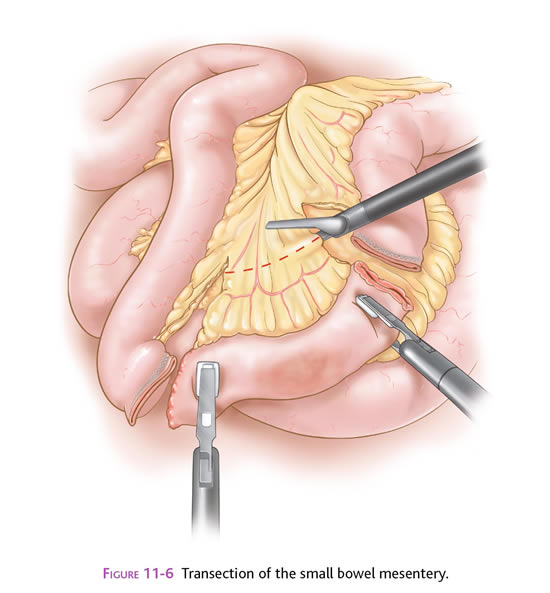Laparoscopic Enterectomy (small bowel resection)
A. The Condition. You may have a tumor or some type of abnormal structure in your small intestine. This can cause bleeding, pain, obstruction, or other problems, so surgical removal usually is indicated.
B. Symptoms
- Nausea and vomiting
- Abdominal pain
- Diarrhea
- Internal bleeding
- Weight loss, weakness
C. Laparoscopic Enterectomy. The surgeon will make about 3-4 small incisions in your abdomen. A port (nozzle) is inserted into one of the slits, and carbon dioxide gas inflates the abdomen. This process allows the surgeon to see inside of your abdomen more easily. A laparoscope is inserted through another port. The laparoscope looks like a telescope with a light and camera on the end so the surgeon can see inside the abdomen. Surgical instruments are placed in the other small openings and used to remove the diseased portion of the small bowel. The specimen of small bowel then is placed into a plastic bag, and removed through one of the small incisions. The bowel is re-connected with surgical staplers that fit through the ports. After this has been accomplished, the carbon dioxide is released out of the abdomen through the slits, and then these sites are closed with sutures or staples, or covered with glue-like bandage and steri-strips.
D. Nonsurgical Treatment. If you have a mass or tumor in the small bowel, then this is best treated with surgery.
E. Risks. The primary risks of laparoscopic enterectomy are:
- Infection of the skin at one of the small ports sites
- Collection of pus inside your abdomen (intraabdominal abscess)
- Postoperative ileus (the intestines slow down/stop working for several days)
- Small bowel obstruction (kinking, twisting, or scarring which blocks the bowel)
- Leakage from the intestinal connection
F. Expectations
1. Before Your Operation. Laparoscopic small bowel resection may be an elective or an emergency procedure. The preoperative evaluation might include blood work, urinalysis, abdominal x-rays, and an abdominal CT scan. You also may have a barium x-ray of your small bowel. If you smoke, then you should stop immediately. If you are taking blood thinners (for example, aspirin, coumadin, Lovenox, or Plavix), then you will need to stop these one week prior to your procedure. Your surgeon and anesthesia provider will review your health history, medications (including blood thinners), and options for pain control.
2. Your Recovery. You usually can go home in 1 or 2 days after a laparoscopic small bowel resection. You will be given medication for pain, and you may be given antibiotic pills. You should limit your activity to light lifting (no more than 15 lb) for one month.
3. Call Your Surgeon if you have one or more of the following:
- Severe pain
- High fever
- Odor or increased drainage from your incision
- No bowel movements for three days
- Nausea, vomiting, and/or crampy abdominal pain
G. Pertinent References.
Frantzides, C.T., Luu M., Challenging Cases of Laparoscopic enterectomy for benign and malignant diseases of the small intestine. Video Atlas of Advanced Minimally Invasive Surgery, Sounders Elsevier pp 193-197; 2013
Zeni T, Bemelman WA, Frantzides CT. Minimally Invasive Procedures on the Small Intestine. In: Frantzides CT, Carlson MA, eds. Atlas of Minimally Invasive Surgery. Philadelphia: Saunders Elsevier, 2009.

